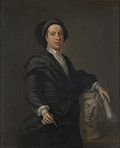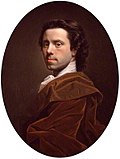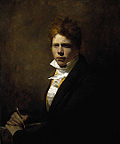
The title of Principal Painter in Ordinary to the King or Queen of England or, later, Great Britain, was awarded to a number of artists, nearly all mainly portraitists. It was different from the role of Serjeant Painter, and similar to the earlier role of "King's Painter". Other painters, for example Nicholas Hilliard had similar roles with different titles. "Principal Painter in Ordinary", first used for Sir Anthony Van Dyck, became settled as the usual title with John Riley in 1689. [1]
Contents
- Born 16th or 17th century
- Born 18th century
- Born 19th century
- Similar titles
- Self-portrait gallery
- See also: Self-portraiture
- References
The title reflected those used in other courts, especially the French Premier peintre du Roi , which dated to 1603. After the death of Queen Victoria in 1901, the appointment of the last and not very distinguished holder, James Sant, who was in his eighties, was not renewed for the new reign.
The following is a partial list of painters (in chronological order) who held the appointment of Principal Painter in Ordinary to the King, or Queen:









